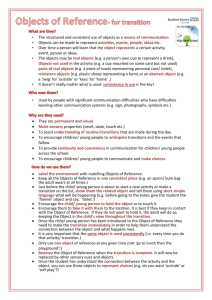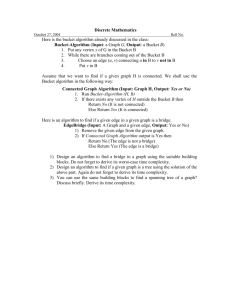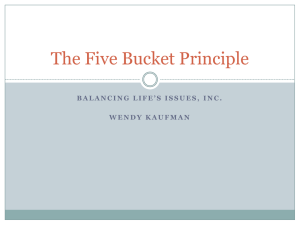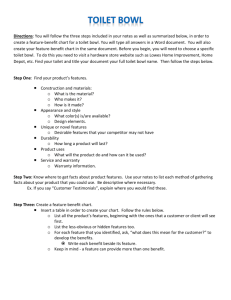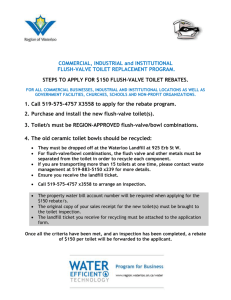Emergency Toilets - Antelope Stake Emergency Preparedness
advertisement
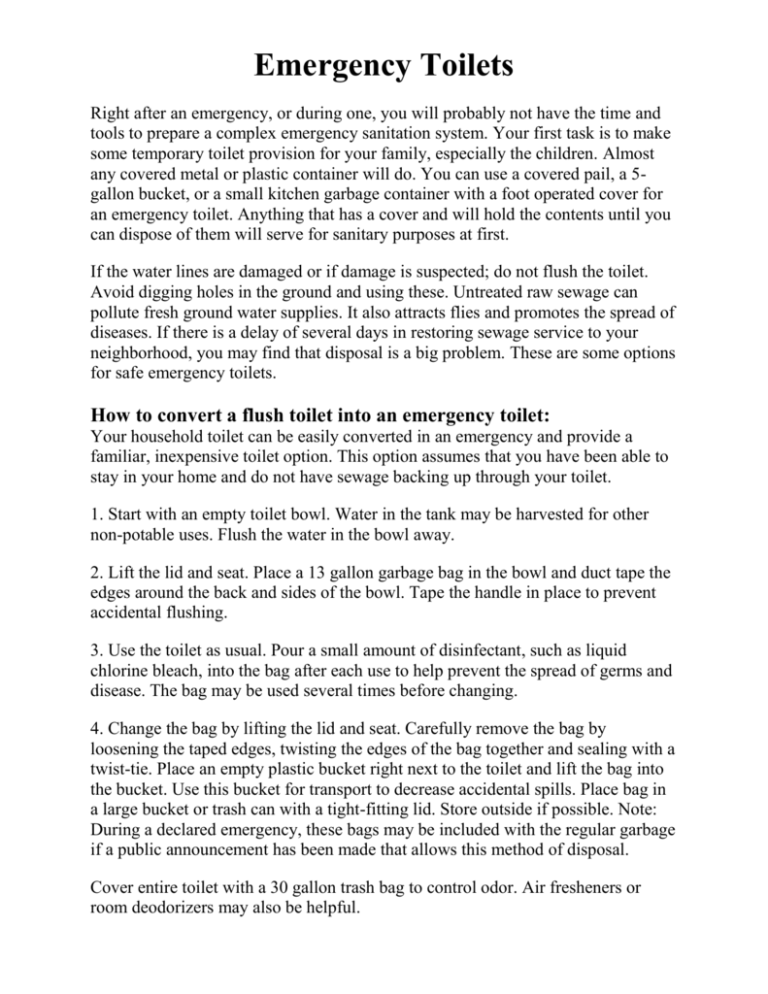
Emergency Toilets Right after an emergency, or during one, you will probably not have the time and tools to prepare a complex emergency sanitation system. Your first task is to make some temporary toilet provision for your family, especially the children. Almost any covered metal or plastic container will do. You can use a covered pail, a 5gallon bucket, or a small kitchen garbage container with a foot operated cover for an emergency toilet. Anything that has a cover and will hold the contents until you can dispose of them will serve for sanitary purposes at first. If the water lines are damaged or if damage is suspected; do not flush the toilet. Avoid digging holes in the ground and using these. Untreated raw sewage can pollute fresh ground water supplies. It also attracts flies and promotes the spread of diseases. If there is a delay of several days in restoring sewage service to your neighborhood, you may find that disposal is a big problem. These are some options for safe emergency toilets. How to convert a flush toilet into an emergency toilet: Your household toilet can be easily converted in an emergency and provide a familiar, inexpensive toilet option. This option assumes that you have been able to stay in your home and do not have sewage backing up through your toilet. 1. Start with an empty toilet bowl. Water in the tank may be harvested for other non-potable uses. Flush the water in the bowl away. 2. Lift the lid and seat. Place a 13 gallon garbage bag in the bowl and duct tape the edges around the back and sides of the bowl. Tape the handle in place to prevent accidental flushing. 3. Use the toilet as usual. Pour a small amount of disinfectant, such as liquid chlorine bleach, into the bag after each use to help prevent the spread of germs and disease. The bag may be used several times before changing. 4. Change the bag by lifting the lid and seat. Carefully remove the bag by loosening the taped edges, twisting the edges of the bag together and sealing with a twist-tie. Place an empty plastic bucket right next to the toilet and lift the bag into the bucket. Use this bucket for transport to decrease accidental spills. Place bag in a large bucket or trash can with a tight-fitting lid. Store outside if possible. Note: During a declared emergency, these bags may be included with the regular garbage if a public announcement has been made that allows this method of disposal. Cover entire toilet with a 30 gallon trash bag to control odor. Air fresheners or room deodorizers may also be helpful. Bucket Toilets You can easily use 5-gallon buckets with tight-fitting lids for emergency toilets. You can purchase snap-on toilet seat bucket lids or place a standard toilet seat over the bucket opening. Alternatively, you can use a pool noodle to make a seat for your bucket by cutting a slit into the middle of the pool noodle along one side so it wraps over the edge of the bucket. Method 1 – Chemical: Line a 5 or 6 gallon bucket with 2 heavy-duty garbage bags. Add about ¼ cup regular, unscented, liquid chlorine bleach as a disinfectant and deodorizer. After using the toilet add ¼ cup liquid chlorine bleach. Cover the container securely when it is not in use. Don't allow any openings in the covering, as these can attract flies or other vermin. Keep the buckets in a cool, dark place. Do not dispose of human waste through your regular trash pickup. When sewer services are restored, flush the waste down the toilet and clean and disinfect the buckets. Method 2 – Dry: Line a 5 or 6 gallon bucket with 2 heavy-duty garbage bags. Add a small layer of dry material (such as kitty litter, sawdust, peat moss, wood shavings, straw, or shredded newspaper). After using the toilet add enough dry material to cover the waste. Cover the container securely when it is not in use. Don't allow any openings in the covering, as these can attract flies or other vermin. Keep the buckets in a cool, dark place. Do not dispose of human waste through your regular trash pickup. Dispose of waste as instructed by emergency management personnel. 2 Bucket Method: Not mixing the urine and feces is a proven principle of ecological sanitation. In separating them, the twin-bucket toilet reduces disease risks and odor and makes the contents of each bucket easier to handle. The solution is to create two different buckets, one for urine and one for feces. This 2 bucket emergency toilet system will serve 3 – 4 people for 3 days. The great thing about pee is that it’s clean & poses almost no health risk. You can store your pee in buckets with lids until it can be sprinkled on land as a fertilizer (it’s a great source of nitrogen) or flushed down the toilet after services are restored. If you live in an apartment and don’t have access to land you may have to save it until the authorities give instructions about the disposal. Feces contains most of the pathogens and needs to be treated or contained until you can dispose of it safely. Feces doesn’t take up much space, about 4 to 10 oz. per person daily. Supplies for 2 bucket emergency toilet system: 2 – 5 gallon buckets 2 tight fitting lids for the buckets 1 plastic toilet seat that fits the buckets securely (or purchase 2 if budget allows) 3 gallons of carbon material like shredded paper, peat moss, sawdust or forest litter 10 pairs of disposable gloves 1 roll of toilet paper (or more) 1 bottle of hand sanitizer, or towels and wipes for hand cleaning 1 plastic scoop for the carbon material Using your 2 Bucket Emergency Toilet: 1. Mark each bucket pee / poo or #1 / #2 2. Place the buckets in a private place with the carbon material and TP near by 3. Add some carbon material to the bottom of the poo bucket (It will make cleanup easier) 4. Decide if you need to use the pee or poo bucket & place seat on bucket. 5. After using the poo bucket sprinkle as much carbon material as needed to completely cover the surface of the poo. This eliminates odors and keeps files away. 6. Make sure each bucket is covered after each use. Put all used TP into the poo bucket. Try not to mix pee and poo, although mistakes are understandable! The pee is the part that produces the bad smell when you mix them.

